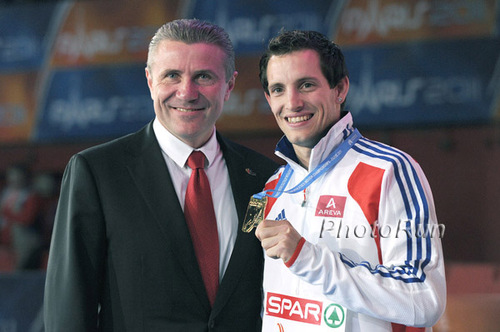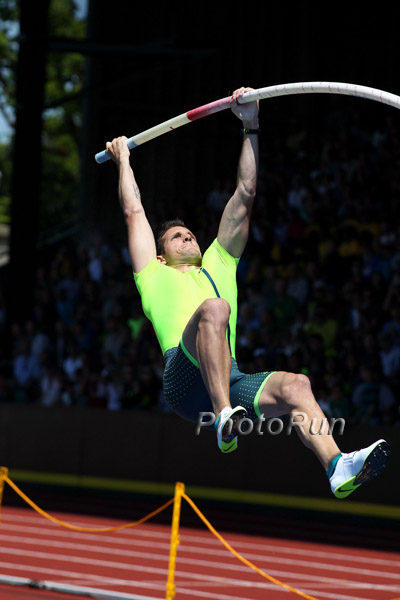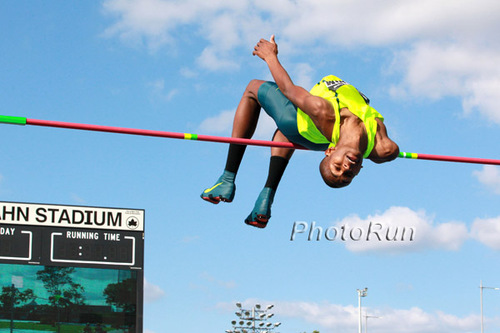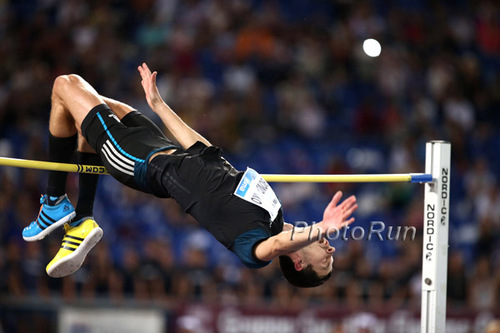Last summer, Dwight Stones proposed a series of pieces on changing the sport of track & field. This is the second, and in his series, Dwight Noise, Mr. Stones should annoy, intrigue and challenge a few of our readers!
Dwight Noise
Punch Up The High Jump and Pole Vault
The high jump and pole vault are unique among track & field events. They are the two “shortest” events in the sport, i.e., high jump world records = 2.09m (6’10¼”, women) and 2.45m (8’½”, men); pole vault world records = 5.06m (16’7¼”, women) and 6.16m (20’2½”, men).
But what truly separates these two events from everything else in the sport is the fact that you only get credit for a clearance at the actual crossbar setting, regardless of how much above the bar your body may fly.
We’ve previously discussed the LJ/TJ, where, like the throwing events, you can post the winning mark on any one of six opportunities, along with being able to set any/all manner of records on any single effort in the competition. Not so with the vertical jumps because of that pesky bar thing.
Renaud Lavillenie, photo by PhotoRun.net
The high jump was my event, and I practiced it at the world-class level for over 16 years, from 1972-88. I made three U.S. Olympic teams and won two bronze medals (1972 and 1976). At 18, I was the youngest member of the men’s track team when I won the 1972 Olympic Trials and went on to win my first Olympic medal. In the four years following those Games, I set 10 world records (3 outdoors, 7 indoors). I was the first high jumper to set the world record using the backwards, Fosbury Flop style, which has been the dominant technique for jumping since the mid-1970s.
As a high jumper, it was my intention to clear the crossbar by no more than a ½” or thereabouts, because I didn’t want to waste any effort. I was acutely aware that I was only going to receive credit for the height at which the bar was measured, so why bother jumping any higher? I was very good at just barely getting over heights, while I watched most of my competitors soar over lower and intermediate settings with many inches to spare, oftentimes in an attempt to bolster their own confidence or psych out their competitors.
All this prologue leads me to my point: There are enormously gifted athletes in both the high jump and pole vault who regularly clear lower and intermediate heights with more than enough room to spare. I’ve seen many competitions where even the winning height is easily cleared, indicating the jumper or vaulter has an even better performance in his or her body. Yet, the athlete usually fails to clear that next height.
Essa Mutaz Barshim jumps over the clouds, photo by PhotoRun.net
I propose the following: Cast an invisible beam, Ã la elevators and garage doors, which records the actual height achieved by a jumper or vaulter, regardless of the crossbar setting. Just as I stated in my LJ/TJ discussion a few months ago, we have the technology to place a device on the high jump and pole vault standards that could extend above the crossbar and measure the jumper’s or vaulter’s true achievement, regardless of the bar setting. I think spectators, both in the arena and at home, would be interested in how high the athlete actually clears.
I’m not suggesting that this innovation be used to determine the winner. I think that would change the dynamics of the events to their detriment. What I’m getting at is keeping two sets of records for the event and creating a new tie-breaking method, along with giving an athlete, and the spectators, a real-time, qualitative measure of the athletes’ performance.
Recently, the IAAF experimented with eliminating the jump-off method for breaking first-place ties in the vertical events. This could lead to two or more athletes sharing the gold medal in Olympics and world championships, an unpleasant development to my way of thinking. Jump-offs are incredibly compelling and the essence of head-to-head competition in these two vertical jumping events.
I propose that; if a tie exists for any place in the competition, the tie be broken by determining who actually jumped higher during the meet, regardless of what height the bar setting was at the time of that clearance. I further suggest that we keep two sets of records, one for how high a bar was cleared and another for how high a jumper/vaulter “actually” jumped/vaulted.
You need look no further than the 2014 season for examples of how this would work in both events. World PV record-holder Renaud Lavillenie of France set his world record in February at an indoor competition in Donetsk, Ukraine–right in front of former world record-holder Sergei Bubka, on the Ukrainian icon’s home turf. But, during the Diamond League season, Lavillenie had several incredible clearances at settings a foot lower than that record and could have challenged his own lifetime best. Likewise, Mutaz Barshim, the Qatarian “jumping bean,” recorded the highest bar clearance in 21 years when he jumped 2.43m (7’11½”) at the Brussels Diamond League event. He also achieved some huge leaps earlier in the season with bar settings in the 2.37m (7’9¼”) range that could well have exceeded the current world record, but we’ll never know how high he really jumped because we aren’t currently set up to discern that.
Bohdan Bondarenko reaches for the stars,
photo by PhotoRun.net
My recurring theme, throughout my discussions of innovating track & field events, is to reward the athletes for what they actually achieve in terms of performance. It’s hard enough to sprint down a runway as fast as you can and launch your body horizontally as far as your skills can carry you without having to also do it for accuracy by hitting as close to the end of a 20cm (8″) piece of wood. Likewise with the high jump. It’s even more difficult to gauge the correct take-off point so that the apex of your flight over the crossbar is precisely above that 2cm (¾”) piece of fiberglass. When you really hit it perfectly and your hips fly well above the bar, you should get credit for that extra defiance of gravity, don’t you think?
No doubt there will always be a segment of the track & field cognoscenti that wants to keep things as they are because that’s the only way to compare past generations with today’s athletes. To that point of view I say, “Hogwash!” If that’s where you stand, then let’s stop running on synthetic tracks. Let’s take away foam rubber landing pits and fiberglass/carbon vaulting poles. And while we’re at it, let’s eliminate starting blocks and return to a prohibition against women running farther than 800 meters.
Innovate or die!
Do you remember when the NBA championship games were on tape delay at 11:30 p.m.? It was prior to Earvin “Magic” Johnson vs. Larry Bird in the 1980s. That rivalry–LA Lakers vs. Boston Celtics–changed professional basketball forever. The NBA knew what it had in that rivalry and ran with it, to the betterment of the sport!
Every professional sports league is looking for ways to present its product in more fan-friendly ways to enhance the entertainment value. MLB constantly strives to shorten the length of regular-season games so there’s never a dull moment in a baseball stadium. Decades ago, tennis and volleyball figured out that to adapt to the spectators’ short attention span, they needed to employ “tie-breakers” and “rally scoring.” Those innovations led to big, network television contracts and exponential increases in fan base and participation.
Innovate or die!
Track & field is a “pure” sport. But that doesn’t mean we must be dictated to by “purists.” If we’re going to compete for the shrinking sports dollar, we have to repackage our product.
To that end, let me propose the following.
If they won’t come to us, we must go to them!
This isn’t a new concept by any stretch of the imagination. The high jump and pole vault have been detached from the traditional track & field arena setting for decades. There are street pole vault, beach pole vault, and even cave pole vault competitions all over the world. Of all events in the sport, the high jump is one of the most “containable” events in terms of competing in a small space. You can stage a world-class high jump competition on a tennis court, in a parking lot, in a shopping mall, or at an intersection.
In 2014, we saw two high jumpers clear 2.37m (7’9¼”) in a grocery store the week prior to the Drake Relays. There’s something magical that happens to most athletes when the crowd is in-close and its collective attention span won’t tolerate a sequence of misses. That’s when you’re able to separate the true “performer” from the run-of-the-mill competitor. It’s also when a “performer” comes to understand that he or she is in the “entertainment business.” This realization tends to stamp a different mindset on those who have excelled in such an environment. They become better competitors at big international championships when they realize they’re competing for the same fan that their colleagues in the major/mainstream sports have been going after for generations.
Stay tuned. I have a series of rants that will address how to innovate all four throwing events, the 100m and 400m, as well as the multi-events. They all involve using technology from the previous century and taking our events to the people instead of expecting the people to come to us. If we effectively market our product to potential fans by bringing events to the general public–up close, personal, and for free–it’ll be like giving a child his first taste of ice cream. He’s likely to be hooked forever.
Track & field desperately needs a game changer, and these innovations in presentation might just be that silver bullet.
Author

Larry Eder has had a 52-year involvement in the sport of athletics. Larry has experienced the sport as an athlete, coach, magazine publisher, and now, journalist and blogger. His first article, on Don Bowden, America's first sub-4 minute miler, was published in RW in 1983. Larry has published several magazines on athletics, from American Athletics to the U.S. version of Spikes magazine. He currently manages the content and marketing development of the RunningNetwork, The Shoe Addicts, and RunBlogRun. Of RunBlogRun, his daily pilgrimage with the sport, Larry says: "I have to admit, I love traveling to far away meets, writing about the sport I love, and the athletes I respect, for my readers at runblogrun.com, the most of anything I have ever done, except, maybe running itself." Also does some updates for BBC Sports at key events, which he truly enjoys. Theme song: Greg Allman, " I'm no Angel."
View all posts
























